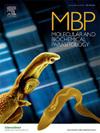蜱虫控制肽基疫苗潜在b细胞表位鉴定的Pepscan和生物信息学策略
IF 1.5
4区 医学
Q4 BIOCHEMISTRY & MOLECULAR BIOLOGY
引用次数: 0
摘要
牛蜱对世界范围内的畜牧业构成了一个重大问题,对杀螨剂的抗性提出了越来越大的挑战。另一方面,疫苗接种被认为是控制蜱虫的更好策略,肽类疫苗可以针对多种蜱虫抗原开发。然而,蜱候选抗原表位的鉴定仍然存在局限性,因为目前可用的生物信息学工具几乎完全是基于哺乳动物基因组开发的。因此,提高b细胞表位预测算法的性能对于实现有效的蜱虫多表位疫苗至关重要。本研究的目的是降低成本,提高识别蜱抗原表位的效率。我们首先评估了b细胞表位预测算法在复制蜱唾液丝氨酸蛋白RmS-17体外表位定位结果作为“基准”方面的性能。然后采用性能最佳的算法预测蜱唾液蛇形蛋白RmS-6的表位,并根据预测结果筛选靠近反应性中心环(RCL)的候选表位,RCL是蛇形蛋白与目标蛋白酶相互作用的区域。针对p1RmS-6和p3RmS-6的抗体可中和RmS-6的活性。使用这种策略,我们能够根据Pepscan结果调整一个计算机算法预测器,以识别另一个serpin中的表位。我们的策略提供了一种具有成本效益的方法来识别蛇形动物中的中和表位。此外,该策略可用于鉴定蛇蛋白和其他蜱虫物种的其他蛋白质的表位,可能导致基于肽的抗蜱虫疫苗的开发。本文章由计算机程序翻译,如有差异,请以英文原文为准。
Pepscan and bioinformatic strategies for identification of potential B-cell epitopes for a peptide-based vaccine for tick control
The cattle tick Rhipicephalus microplus poses a major problem to the livestock industry worldwide, with acaricides resistance presenting an increasing challenge. On other hand, vaccination has been suggested as a better strategy for tick control, and peptide-based vaccines could be developed to target multiple tick antigens. Nevertheless, there are still limitations to the identification of epitopes in tick candidate antigens, as the bioinformatics tools currently available were developed almost exclusively based on mammalian genomes. Therefore, improving the performance of B-cell epitope predictor algorithms is essential to achieve an effective multi-epitope vaccine for tick control. The aim of this study was to reduce costs and increase the efficacy in identifying epitopes in tick antigens. We first evaluated the performance of B-cell epitope predictor algorithms in replicating the results of an in vitro epitope mapping result for the tick salivary serpin RmS-17 as a “benchmark”. Then the algorithm with the best performance was employed to predict epitopes for the tick salivary serpin RmS-6, and we screened the candidate epitopes based on predictions that were close to the reactive center loop (RCL), the region of the serpin that interacts with the target protease. Antibodies raised against p1RmS-6 and p3RmS-6 neutralize RmS-6 activity. Using this strategy, we were able to adjust an in silico algorithm predictor based on a Pepscan result to identify epitopes in another serpin. Our strategy offers a cost-effective way to identify neutralizing epitopes in serpins. Furthermore, this strategy can be applied to identify epitopes in serpins and other proteins from other tick species, potentially leading to the development of a peptide-based anti-tick vaccine.
求助全文
通过发布文献求助,成功后即可免费获取论文全文。
去求助
来源期刊
CiteScore
2.90
自引率
0.00%
发文量
51
审稿时长
63 days
期刊介绍:
The journal provides a medium for rapid publication of investigations of the molecular biology and biochemistry of parasitic protozoa and helminths and their interactions with both the definitive and intermediate host. The main subject areas covered are:
• the structure, biosynthesis, degradation, properties and function of DNA, RNA, proteins, lipids, carbohydrates and small molecular-weight substances
• intermediary metabolism and bioenergetics
• drug target characterization and the mode of action of antiparasitic drugs
• molecular and biochemical aspects of membrane structure and function
• host-parasite relationships that focus on the parasite, particularly as related to specific parasite molecules.
• analysis of genes and genome structure, function and expression
• analysis of variation in parasite populations relevant to genetic exchange, pathogenesis, drug and vaccine target characterization, and drug resistance.
• parasite protein trafficking, organelle biogenesis, and cellular structure especially with reference to the roles of specific molecules
• parasite programmed cell death, development, and cell division at the molecular level.

 求助内容:
求助内容: 应助结果提醒方式:
应助结果提醒方式:


